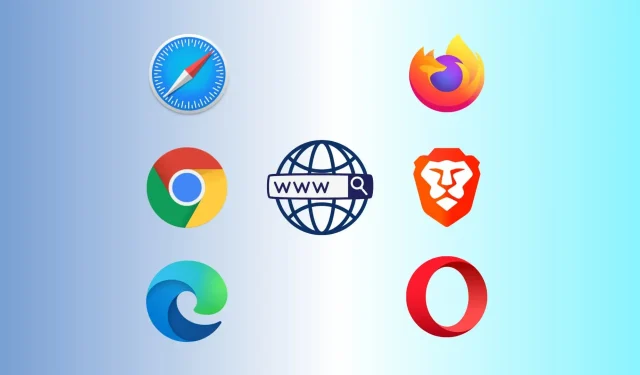It is extremely important to update browsers such as Safari, Chrome, Firefox, Edge, Opera, Brave, etc. on iPhone, iPad and Mac regularly. In this security guide, we’ll tell you why and how to make sure your Apple devices always have the latest version of the web browser.
Why should I care about updating web browsers?
The web browser is your means of accessing the Internet. It handles basic activities such as logging into your internet banking, checking email, booking hotels and plane tickets with your credit card, uploading documents to sensitive websites, filling out job applications, using social media, and more. other.
Hackers and malicious agents are constantly improving their methods to get hold of your personal data such as email, address, phone number, financial details, etc.
To ensure security, all leading browsers are constantly releasing updates to fix bugs and fix any dangerous loopholes. Therefore, keeping your web browsers up to date regularly is of the utmost importance to ensure security.
In addition, almost all web browsers have a built-in password manager. Thus, in order to keep your usernames and passwords properly secure, it is essential that you update your browsers regularly.
How to update web browsers on iPhone and iPad
safari
The only way to update the Safari browser on iPhone and iPad is to get the latest version of iOS or iPadOS by going to Settings > General > Software Update. This is because Apple does not publish individual updates to its built-in core apps and handles their updates through iOS updates.
Chrome, Firefox, Edge, Opera, Brave and other browsers
Follow these steps to update any other third party web browser on your iPhone or iPad:
- Click the App Store icon and select Updates.
- Pull down the account screen to update it.
- Click UPDATE next to Google Chrome, Edge, Firefox, or whatever browser you’re using.
To keep your web browsers (and all other apps) up to date automatically, go to Settings > App Store and turn on App Updates.
How to update browsers on Mac
Here are the steps to update all leading browsers on Mac.
safari
As with iPhone and iPad, Safari updates on Mac are handled by macOS updates. To make sure your Mac has the latest version of Safari, go to System Preferences and click on Software Update. From here, download and install any pending macOS update.
Advice. Sometimes you may see a standalone update for Safari. To do this, go to “System Preferences”> “Software Update”and click “Details”. Here, uncheck macOS update and select the update for Safari browser only.
Chrome
Most popular browsers, including Chrome, are automatically updated in the background when you close and reopen your browser. However, if you haven’t done this in a while, you’ll see the word Refresh in the top right corner of the Chrome window. Just click on it and you’re done.
Alternatively, you can also follow these steps to make sure Chrome is up to date on your Mac:
- Open Chrome and press Command + Comma (,).
- Click “About Chrome”in the lower left corner.
- Select Update Google Chrome.
Note. If you don’t see the Update Google Chrome button, it means that your browser has already been updated. In such cases, it will say “Chrome is up to date”and the version number.
fire fox
Firefox automatically updates in the background when you close and reopen it. After that, it usually shows you a web page highlighting the new changes. However, to be sure, follow these steps to manually check for Firefox updates on your Mac:
- Open Firefox and press Command + Comma (,) to see its settings.
- Scroll down the General section and you will see Firefox Updates.
- Click Check for updates.
Brave
Follow these steps to update the Brave browser on your Mac:
- Open Brave and navigate to its settings by pressing Command + Comma (,).
- Click Privacy and Security.
- Scroll down and under Security Check, click Check Now. The browser will check for pending updates and download them.
- Once downloaded, click “Relaunch”to complete the Brave browser update.
Opera
Here’s how to update the Opera browser on your Mac:
- Open your browser and click the word Opera in the top menu bar.
- Select “Update and Recovery”.
- Click Check for updates.
edge
When you install and open Edge on your Mac for the first time, it opens the Microsoft AutoUpdate tool. That being said, if you check the “Automatically update Microsoft apps”checkbox, the update tool will automatically update all of your Microsoft apps, including Edge.
Follow these steps to manually update Microsoft Edge on your Mac:
- Open Edge on your Mac.
- Select Help from the top menu bar.
- Click Update Microsoft Edge.
Here’s how you can install the latest web browsers on your iPhone, iPad, and Mac. Even if you are using any other browser not mentioned in this post, the steps to update it should be almost identical.
Update web browsers on iOS, iPadOS and macOS
Third party browsers on Mac do a great job and refresh periodically in the background when you exit and reopen them. This ensures a secure online experience with little or no manual labor.
Similarly, if you enable automatic app updates on your iPhone or iPad, your third-party browsers will always be up to date with all new features and security updates.
However, the problems start with updating Safari, as its updates are handled by updating the entire operating system – iOS, iPadOS, and macOS. Compared to regular app updates, full software updates take a long time to download and install. Keep in mind that your device cannot be used while the update is being installed. Also, some people who have a limited or slow internet connection or little free space may not update their operating systems as regularly.
However, to keep Safari up to date, you can turn on an option that automatically updates your iPhone, iPad, and Mac. Here’s how:


